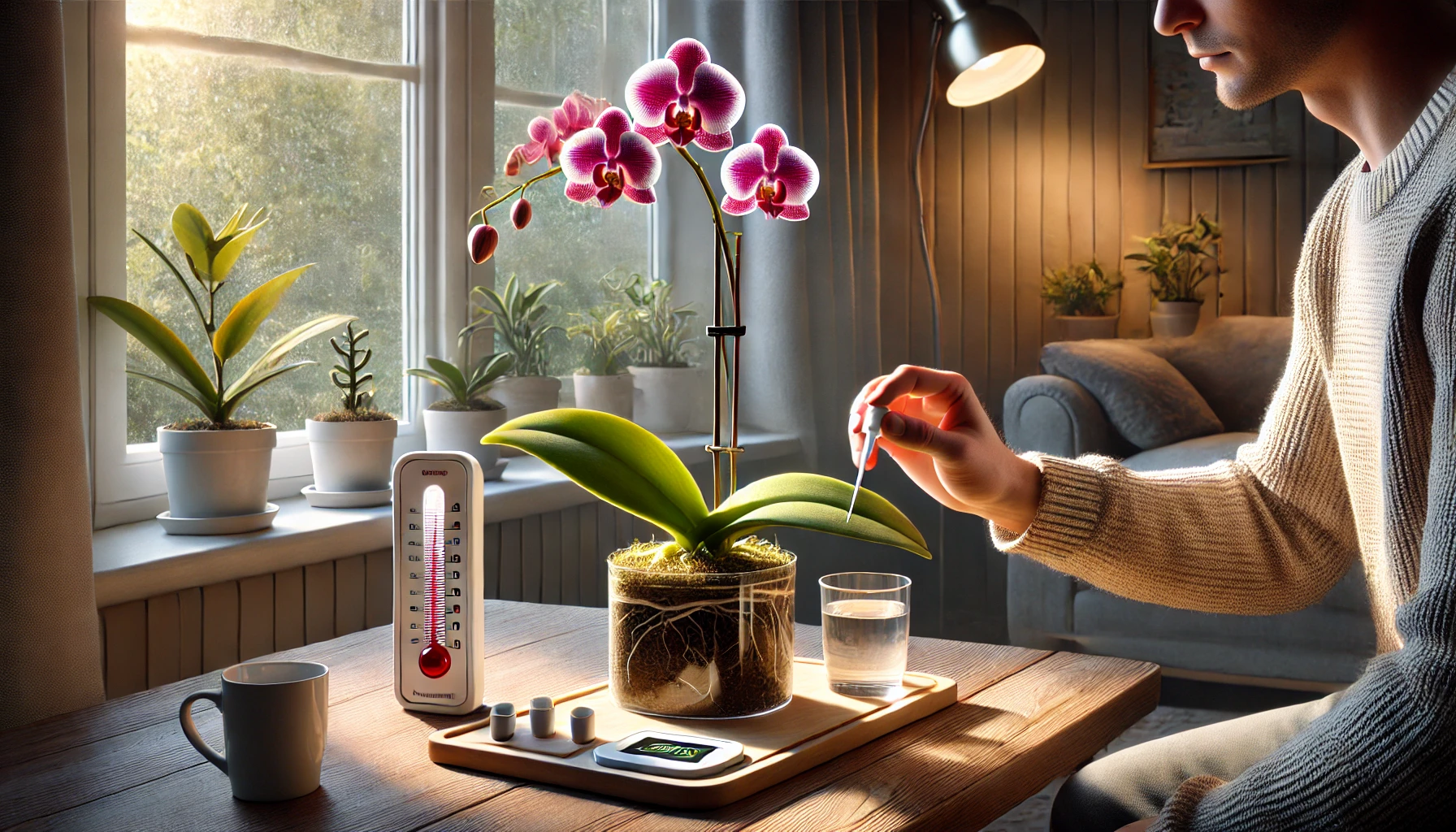Many orchid owners become frustrated when their plant stops blooming for months or even years. While orchids naturally go through a dormant phase, some take longer than expected to rebloom. If your orchid has healthy leaves and roots but isn’t producing flowers, don’t worry! With the right care adjustments, you can encourage it to bloom again.
🌱 Why Do Orchids Stop Blooming?
Orchids may not bloom for several reasons, including insufficient light, improper temperatures, lack of nutrients, or incorrect watering. During dormancy, the plant stores energy for its next bloom cycle, but if conditions aren’t ideal, it may delay flowering indefinitely.
✔ Common Reasons an Orchid Won’t Bloom:
- Not enough light – Orchid leaves are dark green instead of bright green.
- Temperature is too stable – No cool night drop to trigger flowering.
- Over-fertilization – Too much nitrogen leads to leaf growth but no blooms.
- Improper watering – Either overwatering or underwatering can cause stress.
- The plant is too young – Some orchids take years before their first bloom.
💡 Good news! If your orchid is producing new leaves and roots, it’s healthy and just needs the right conditions to bloom again.
🌞 Step 1: Increase Light Exposure
Orchids need bright, indirect light to bloom. If your orchid is in a low-light environment, it may never produce a flower spike.
✔ How to Provide More Light:
- Move the orchid to an east or south-facing window.
- If natural light is weak, use a full-spectrum LED grow light for 10–12 hours daily.
- Monitor leaf color—bright green leaves indicate the right light level.
❌ Warning: Direct sunlight can cause leaf burn. If moving to a brighter location, introduce light gradually.
🌡 Step 2: Adjust Temperature to Trigger Flowering
Orchids, especially Phalaenopsis, need a temperature drop at night to signal that it’s time to bloom. If your orchid is in a room with constant temperatures, it may not flower.
✔ How to Use Temperature to Induce Blooms:
- Maintain 65–75°F (18–24°C) during the day and 55–65°F (13–18°C) at night.
- Move the orchid to a cooler room or near a window at night.
- If temperatures are too warm, place the orchid near a slightly open window for cooler air.
💡 Keep this temperature change for 3–4 weeks to trigger a new flower spike.
💧 Step 3: Adjust Watering Routine
Orchids need less water during dormancy but must be kept hydrated enough to support a new flower spike.
✔ Best Watering Practices for Reblooming:
- Water only when the roots turn silvery-white.
- Avoid watering too often, which can lead to root rot.
- Reduce watering slightly after blooming ends to mimic natural conditions.
- Once a new flower spike appears, resume normal watering.
💡 Orchids are more likely to bloom when they experience a natural cycle of slightly drier periods followed by increased hydration.
🍃 Step 4: Use the Right Fertilizer for Flowering
If your orchid is growing leaves but not flowers, it may be receiving too much nitrogen. A fertilizer high in nitrogen promotes leaf growth at the expense of blooms.
✔ How to Fertilize for Blooming:
- Use a balanced orchid fertilizer (20-20-20) every two weeks during active growth.
- When a flower spike is expected, switch to a bloom booster (10-30-20) fertilizer.
- Reduce fertilizer use during dormancy.
💡 Too much fertilizer can harm orchids. Always dilute to half strength before applying.
🌱 Step 5: Check for a Healthy Root System
An orchid with unhealthy roots will struggle to bloom. If the roots are rotting or dry, the plant won’t have enough energy for flowering.
✔ How to Keep Roots Healthy:
- Use a well-draining orchid mix (bark + sphagnum moss + perlite).
- Ensure the pot has good drainage holes.
- If roots are rotting or overcrowded, repot the orchid in fresh mix.
- Never let the orchid sit in standing water—this leads to root rot.
💡 Healthy roots = a healthy orchid. A plant with strong roots is more likely to flower.
📏 Step 6: Monitor Flower Spike Growth
Once conditions are right, your orchid will produce a new flower spike. This is a long, slender stem that grows from the base of the plant.
✔ Signs That Your Orchid Is Preparing to Bloom:
- A new spike emerges from between leaves, growing upward.
- The spike develops small bumps (buds) along its length.
- The plant uses more water, indicating active growth.
🌸 How to Care for an Orchid During Flower Spike Growth:
- Support the spike with a small orchid stake to prevent bending.
- Avoid moving the orchid too much—sudden changes can cause bud blast (flower buds falling off).
- Continue bloom booster fertilization until flowers open.
❌ If no flower spike appears after several months, check for possible causes: too little light, wrong temperature, or too much nitrogen.
🚫 Common Mistakes That Prevent Orchids from Blooming
❌ Keeping the orchid in low light – Even low-light orchids need moderate brightness to flower.
❌ Forgetting the nighttime temperature drop – Warm nights can prevent blooming.
❌ Over-fertilizing with nitrogen – This leads to leaves instead of flowers.
❌ Watering too much or too little – Improper hydration stresses the plant.
❌ Ignoring root health – Rotting or dry roots prevent energy storage for blooming.
🛡 Final Tips for Training Your Orchid to Bloom Again
✔ Ensure bright, indirect light—orchids won’t bloom in deep shade.
✔ Create a cool nighttime temperature drop to stimulate flower spike growth.
✔ Water correctly—not too much, not too little.
✔ Switch to a bloom-boosting fertilizer (10-30-20) when flower spikes appear.
✔ Be patient—some orchids take months to rebloom, but consistent care will reward you!
By following these steps, you can train your orchid to bloom again and enjoy its stunning flowers for months. With proper light, temperature, and care, your orchid will return to full bloom and brighten your home once again! 🌸✨
